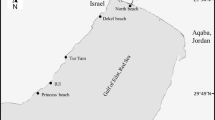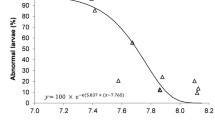Abstract
Ocean acidification, as a result of increased atmospheric CO2, is predicted to lower the pH of seawater to between pH 7.6 and 7.8 over the next 100 years. The greatest changes are expected in polar waters. Our research aimed to examine how echinoid larvae are affected by lower pH, and if effects are more pronounced in polar species. We examined the effects of lowered pH on larvae from tropical (Tripneustes gratilla), temperate (Pseudechinus huttoni, Evechinus chloroticus), and a polar species (Sterechinus neumayeri) in a series of laboratory experiments. Larvae were reared in a range of lower pH seawater (pH 6.0, 6.5, 7.0, 7.5, 7.7, 7.8 and ambient), adjusted by bubbling CO2 gas. The effect of pH on somatic and skeletal growth, calcification index, development and survival were quantified, while SEM examination of the larval skeleton provided information on the effects of seawater pH on the fine-scale skeletal morphology. Lowering pH resulted in a decrease in survival in all species, but only below pH 7.0. The size of larvae were reduced at lowered pH, but the external morphology (shape) was unaffected. Calcification of the larval skeleton was significantly reduced (13.8–36.9% lower) under lowered pH, with the exception of the Antarctic species, which showed no significant difference. SEM examination revealed a degradation of the larval skeletons of Pseudechinus and Evechinus when grown in reduced pH. Sterechinus and Tripneustes showed no apparent difference in the skeletal fine structure under lowered pH. The study confirms the need to look beyond mortality as a single endpoint when considering the effects of ocean acidification that may occur through the 21st century, and instead, look for a suite of more subtle changes, which may indirectly affect the functioning of larval stages.




Similar content being viewed by others
References
Beniash E, Aizenberg J, Addadi L, Weiner S (1997) Amorphous calcium carbonate transforms into calcite during sea urchin larval spicule growth. Proc R Soc Lond B 264:461–465. doi:https://doi.org/10.1098/rspb.1997.0066
Borowitzka MA (1981) Photosynthesis and calcification in the articulated coralline red algae Amphiroa anceps and A. foliacea. Mar Biol 62:17–23. doi:https://doi.org/10.1007/BF00396947
Caldeira K, Wickett ME (2003) Anthropogenic carbon and ocean pH. Nature 425:365. doi:https://doi.org/10.1038/425365a
Caldeira K, Wickett ME (2005) Ocean model predictions of chemistry changes from carbon dioxide emissions to the atmosphere and ocean. J Geophys Res 110:C09S04. doi:https://doi.org/10.1029/2004JC002671
Cicerone R, Orr JC (2004) The Ocean in a high CO2 world. EOS Trans Am Geophys Union 85:351–353. doi:https://doi.org/10.1029/2004EO370007
Clarke A (1983) Life in cold water: the physiological ecology of polar marine ectotherms. Oceanogr Mar Biol Annu Rev 21:341–453
Currie KI, Hunter KA (1998) Surface water carbon dioxide in the waters associated with the subtropical convergence east of New Zealand. Deep Sea Res I 45:1765–1777. doi:https://doi.org/10.1016/S0967-0637(98)00041-7
Dickson AG, Millero FJ (1987) A comparison of the equilibrium constants for the dissociation of carbonic acid in seawater media. Deep Sea Res 34:1733–1743. doi:https://doi.org/10.1016/0198-0149(87)90021-5
Fabry VJ, Seibel BA, Feely RA, Orr JC (2008) Impacts of ocean acidification on marine fauna and ecosystem processes. ICES J Mar Sci 65:414–432. doi:https://doi.org/10.1093/icesjms/fsn048
Feely RA, Sabine CL, Lee K, Berelson W, Kleypas J, Fabry VJ, Millero FJ (2004) Impact of anthropogenic CO2 on the CaCO3 system in the oceans. Science 305:362–366
Gao K, Aruga Y, Asada K, Ishihara T, Akano T, Kiyohara M (1993) Calcification in the articulated coralline alga Corallina pilulifera, with special reference to the effect of elevated CO2 concentration. Mar Biol 117:129–132. doi:https://doi.org/10.1007/BF00346434
Gattuso J-P, Allemand D, Frankignoulle M (1999) Photosynthesis and calcification at cellular, organismal and community levels in coral reefs: a review on interactions and control by carbonate chemistry. Am Zool 39:160–183
Gazeau F, Quiblier C, Jansen JM, Gattuso J-P, Middelburg JJ, Heip CHR (2007) Impact of elevated CO2 on shellfish calcification. Geophys Res Lett 34:L07603. doi:https://doi.org/10.1029/2006GL028554
Havenhand JN, Buttler F-R, Thorndyke MC, Williamson JE (2008) Near-future levels of ocean acidification reduce fertilization success in a sea urchin. Curr Biol 18:651–652
Killian CE, Wilt FH (2008) Molecular aspects of biomineralisation of the echinoderm endoskeleton. Chem Rev 108:4463–4474
Knutzen J (1981) Effects of decreased pH on marine organisms. Mar Pollut Bull 12(1):25–29. doi:https://doi.org/10.1016/0025-326X(81)90136-3
Kurihara H (2008) Effects of CO2-driven ocean acidification on the early developmental stages of invertebrates. Mar Ecol Prog Ser 373:275–284
Kurihara H, Shirayama Y (2004) Effects of increased atmospheric CO2 on sea urchin early development. Mar Ecol Prog Ser 274:161–169. doi:https://doi.org/10.3354/meps274161
Kurihara H, Shimode S, Shirayama Y (2004) Sub-lethal effects of elevated concentration of CO2 on planktonic copepods and sea urchins. J Oceanogr 60:743–750. doi:https://doi.org/10.1007/s10872-004-5766-x
Lamare MD, Barker MF (1999) In situ estimates of larval development and mortality in the New Zealand sea urchin Evechinus chloroticus (Echinodermata: Echinoidea). Mar Ecol Prog Ser 180:197–211
Lamare MD, Barker MF, Lesser MP, Marshall CJ (2006) DNA repair in echinoid embryos: effects of temperature on repair rate in Antarctic and non-Antarctic species. J Exp Biol 209:5017–5028
Langdon C, Takahashi T, Sweeney C, Chipman D, Goddard J, Marubini F, Aceves H, Barnett H, Atkinson MJ (2000) Effect of calcium carbonate saturation state on the calcification rate of an experimental coral reef. Glob Biogeochem Cycles 14:639–654. doi:https://doi.org/10.1029/1999GB001195
Lawrence JM (2007) Edible sea urchins: biology and ecology, 2nd edn. Elsevier, Amsterdam
LeClercq N, Gattuso J-P, Jaubert J (2000) CO2 partial pressure controls the calcification rate of a coral community. Glob Chang Biol 6:329–334
Lee K, Tong LT, Millero FJ, Sabine CL, Dickson AG, Goyet C, Park G-H, Wanninkhof R, Feely RA, Key RM (2006) Global relationships of total alkalinity with salinity and temperature in surface waters of the world’s oceans. Geophys Res Lett 33:L19605
Lowenstam HA, Weiner S (1989) On mineralization. Oxford University Press, New York
Marubini F, Thake B (1999) Bicarbonate addition promotes coral growth. Limnol Oceanogr 43:716–720
Marubini F, Ferrier-Pages C, Cuif J-P (2003) Suppression of skeletal growth in scleractinian corals by decreasing ambient carbonate-ion concentration: a cross-family comparison. Proc R Soc Lond B 270:179–184
McEdward LR, Miner BG (2007) Echinoid larval ecology. In: Lawrence JM (ed) Edible sea urchins: biology and ecology, 2nd edn. Elsevier, Amsterdam, pp 71–93
Mehrbach C, Culberson CH, Hawley JE, Pytkowicz RM (1973) Measurement of apparent dissociation constants of carbonic acid in seawater at atmospheric pressure. Limnol Oceanogr 18:897–907
Ohline SM, Reid MR, Husheer SLG, Currie KI, Hunter KA (2007) Spectrophotometric determination of pH in seawater off Taiaroa Head, Otago, New Zealand: full-spectrum modelling and prediction of pCO2 levels. Mar Chem 107:143–155
Orr JC, Fabry VJ, Aumont O, Bopp L, Doney SC, Feely RA, Gnanadesikan A, Gruber N, Ishida A, Joos F, Key RM, Lindsay K, Maier-Reimer E, Matear R, Monfray P, Mouchet A, Najjar RG, Plattner G-K, Rodgers KB, Sabine CL, Sarmiento JL, Schlitzer R, Slater RD, Totterdell IJ, Weirig M-F, Yamanaka Y, Yool A (2005) Anthropogenic ocean acidification over the twenty-first century and its impact on calcifying organisms. Nature 437:681–686
Politi Y, Arad T, Klein E, Weiner S, Addadi L (2004) Sea urchin spine calcite forms via a transient amorphous calcium phase. Science 306(5699):1161–1165
Pörtner HO (2008) Ecosystem effects of ocean acidification in times of ocean warming: a physiologist’s view. Mar Ecol Prog Ser 373:203–217
Raven JA, Caldeira K, Elderfield H, Hoegh-Guldberg O, Liss P, Riebesell U, Shepherd J, Turley C, Watson A (2005) Ocean acidification due to increasing atmospheric carbon dioxide. Policy document 12/05, Royal Society, London
Reynaud S, Leclercq N, Romaine-Lioud S, Ferrier-Pagés C, Jaubert J, Gattuso J-P (2003) Interacting effects of CO2 partial pressure and temperature on photosynthesis and calcification in a scleractinian coral. Glob Chang Biol 9:1660–1668
Riebesell U, Zondervan I, Rost B, Tortell PD, Zeebe RE, Morel FMM (2000) Reduced calcification of marine plankton in response to increased atmospheric CO2. Nature 407:364–367
Rumrill SS (1990) Natural mortality of marine invertebrate larvae. Ophelia 32:163–198
Sabine CL, Feely RA, Gruber N, Key RM, Lee K, Bullister JL et al (2004) The oceanic sink for anthropogenic CO2. Science 305:367–371
Sciandra A, Harlay J, Lefevre D, Lemee R, Rimmelin P, Denis M, Gattuso J-P (2003) Response of coccolithophorid Emiliania huxleyi to elevated partial pressure of CO2 under nitrogen limitation. Mar Ecol Prog Ser 261:111–122
Shilling FM, Manahan DT (1994) Energy metabolism and amino acid transport during early development of Antarctic and temperate echinoderms. Biol Bull 187:398–407
Shirayama Y, Thornton H (2005) Effect of increased atmospheric CO2 concentration on shallow water marine benthos. J Geophys Res 110:108–115
Spero HJ, Bijma J, Lee DW, Bemis BE (1997) Effects of seawater carbonate concentration on foraminiferal carbon and oxygen isotopes. Nature 390:497–500
Takahashi T, Sutherland SC, Sweeney C, Poisson A, Metzl N, Tilbrook B, Bates N, Wanninkhof R, Feely RA, Sabine C, Olafsson J, Nojiri Y (2002) Global sea-air CO2 flux based on climatological surface ocean pCO2, and seasonal biological and temperature effects. Deep Sea Res II 49:1601–1622
Underwood AJ (1997) Experiments in ecology: their logical design and interpretation using analysis of variance. Cambridge University Press, Cambridge
Wanninkhof R, Lewis E, Feely RA, Millero FJ (1999) The optimal carbonate dissociation constants for determining surface water pCO2 from alkalinity and total inorganic carbon. Mar Chem 65:291–301
Yamada Y, Ikeda T (1999) Acute toxicity of lowered pH to some oceanic zooplankton. Plankton Biol Ecol 46(1):62–67
Zondervan I, Zeebe RE, Rost B, Riebesell U (2001) Decreasing marine biogenic calcification: a negative feedback on rising atmospheric pCO2. Glob Biogeochem Cycles 15:507–516
Acknowledgments
We thank Antarctica New Zealand for their logistical support in Antarctica, and Ian Bertram and The Cook Islands Ministry of Marine Resources for assisting in research at Aitutaki. Thanks to Richard Story, manager of the Cook Island Marine Research Centre, and staff at the Portobello Marine Laboratory, University of Otago. Professor Keith Hunter provided expert information on carbonate chemistry. Professor Hunter also developed the software we used for determining the carbonate chemistry of seawater. Liz Girvan provided expertise during SEM preparation and imaging. This research was generously supported by a University of Otago Research Grant (MDL, MFB). Dana Clark was awarded a Brenda Shore Award from the Federation of Graduate Women, Otago Branch, which supported her Post-graduate research activities.
Author information
Authors and Affiliations
Corresponding author
Additional information
Communicated by S. A. Poulet.
Rights and permissions
About this article
Cite this article
Clark, D., Lamare, M. & Barker, M. Response of sea urchin pluteus larvae (Echinodermata: Echinoidea) to reduced seawater pH: a comparison among a tropical, temperate, and a polar species. Mar Biol 156, 1125–1137 (2009). https://doi.org/10.1007/s00227-009-1155-8
Received:
Accepted:
Published:
Issue Date:
DOI: https://doi.org/10.1007/s00227-009-1155-8




